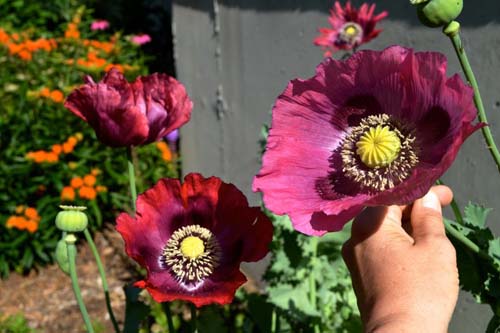
Think Thinning!
Nancy DuBruleShare
When you grow plants from seed, it is important to be courageous and THIN your seeds. A lot of new gardeners simply can’t bring themselves to do this as they feel like they are “wasting” lots of plants. In addition, lots of folks feel the need to replant everything they thin out. I understand completely, I used to feel that way too!

Look at the photo above. I direct seeded radishes in my garden. They are WAY too close together and need to be thinned...fast.
Thinning is critically important in order to grow full sized, healthy plants. With large seeds like beans and sunflowers, if you are patient, you can drop the seed in trenches spaced the proper distance apart because they are easy to handle. But the smaller the seed gets, the harder it is to sow it at the proper spacing. Some seeds are so tiny, they look like specks of dust.

These carrots need thinning!
Carrots are the first crop that I learned to thin- the hard way. The first few times I planted carrots they were tiny. A disaster. I realized that if I summon up the courage to ruthlessly thin them, I would never have a successful crop. So, I did it and at first, I felt guilty discarding all those tiny, baby plants that I had so lovingly raised. But the results were so good, I was hooked. I FINALLY grew big, juicy, delicious carrots. And I have never looked back.

I adore golden beets, for the delicious roots and the edible greens. If I didn't thin them after the seedlings emerged, they wouldn't end up being this gorgeous.
Beets are another vegetable I love to grow that I must thin once they germinate. Beets are a bit easier to sow as the seed is bigger BUT each beet seed is actually a few seeds in one. If you are very patient sowing beet seeds, you can wait until the seedlings have a few baby leaves and then EAT the thinnings as baby beet greens. But you can’t let them go too long or your beets won’t form properly. Instead of pulling them up, consider cutting them with small scissors so you don’t disturb the beets you leave in the ground.

Look at this great harvest of 'Mikado' baby turnips that I picked last spring. They were thinned after they sprouted and harvested when they reached the size of radishes.
One way to deal with direct sowing seeds that always need thinning is to mix the seed with some fine sand. This dilutes the rate at which the seed is sown and reduces the thinning dramatically. Use a 4-1 ratio of sand to seed, shake well, and sow. Play around with this method and eventually you will find you will be thinning less!

Read your seed packet to find out how far apart you should thin your seedlings. All seed packets have this information. I never use a ruler, I just eyeball the distance, but I now seriously do pay attention. Sometimes I just use my judgement, thinking: “How big is a radish going to get?” and thin accordingly!

I have spent this post talking about thinning vegetable seedlings, but it is also important for flowers. The number one flower that MUST be thinned are breadseed poppies. If you just let them grow too close together, you won’t get the beautiful big, dramatic flowers that we post pictures of all the time.
